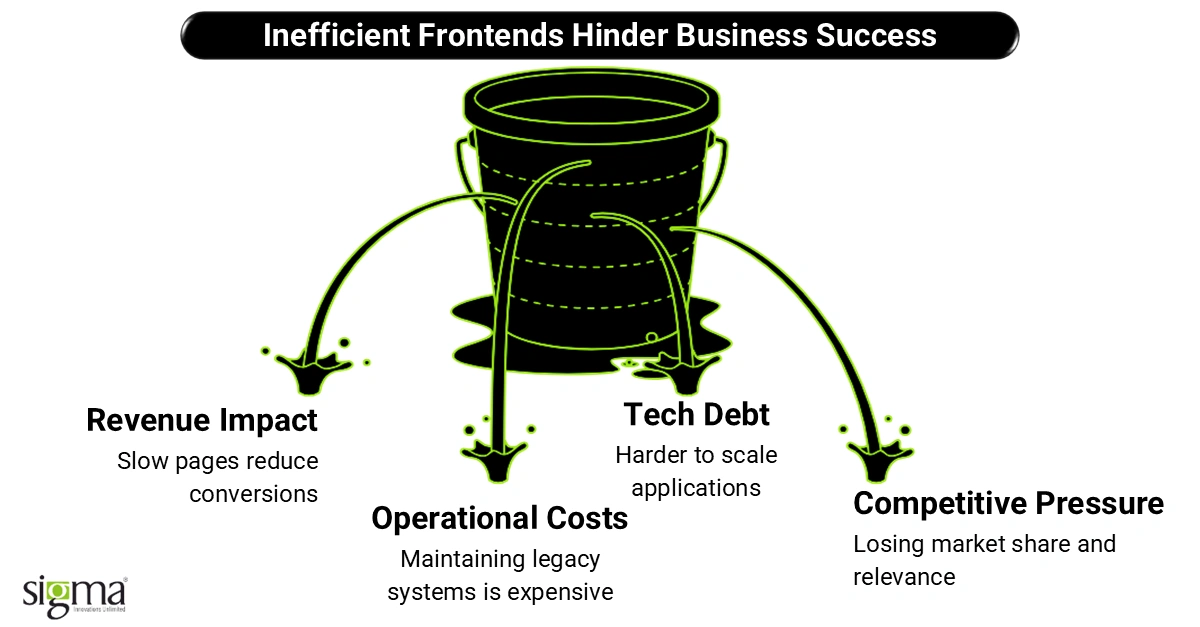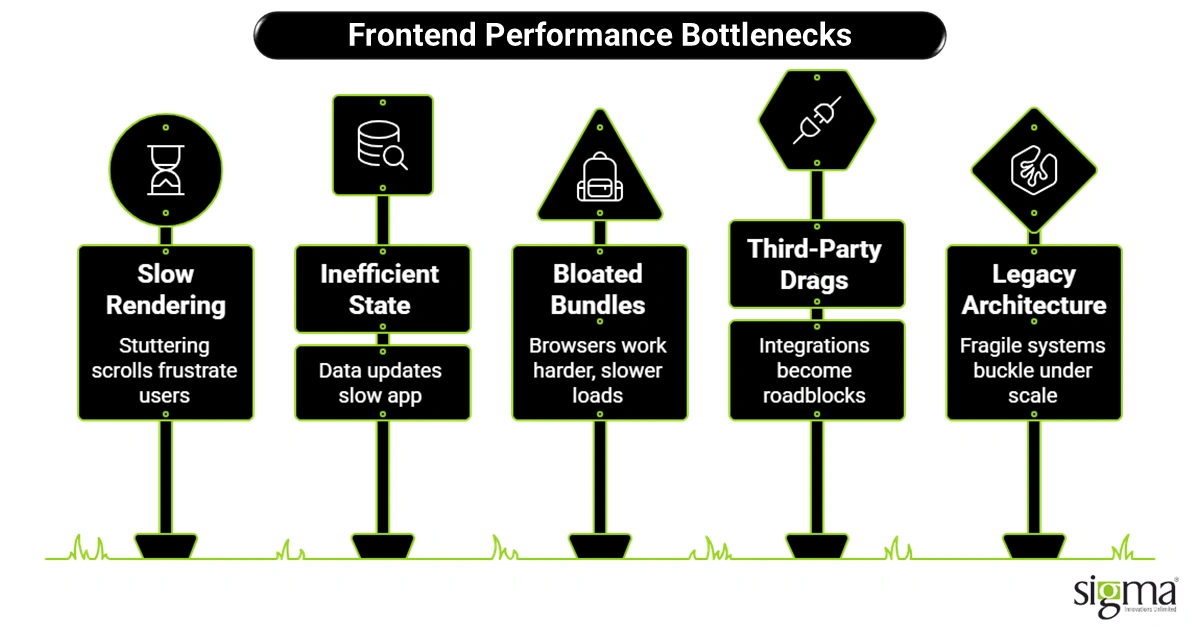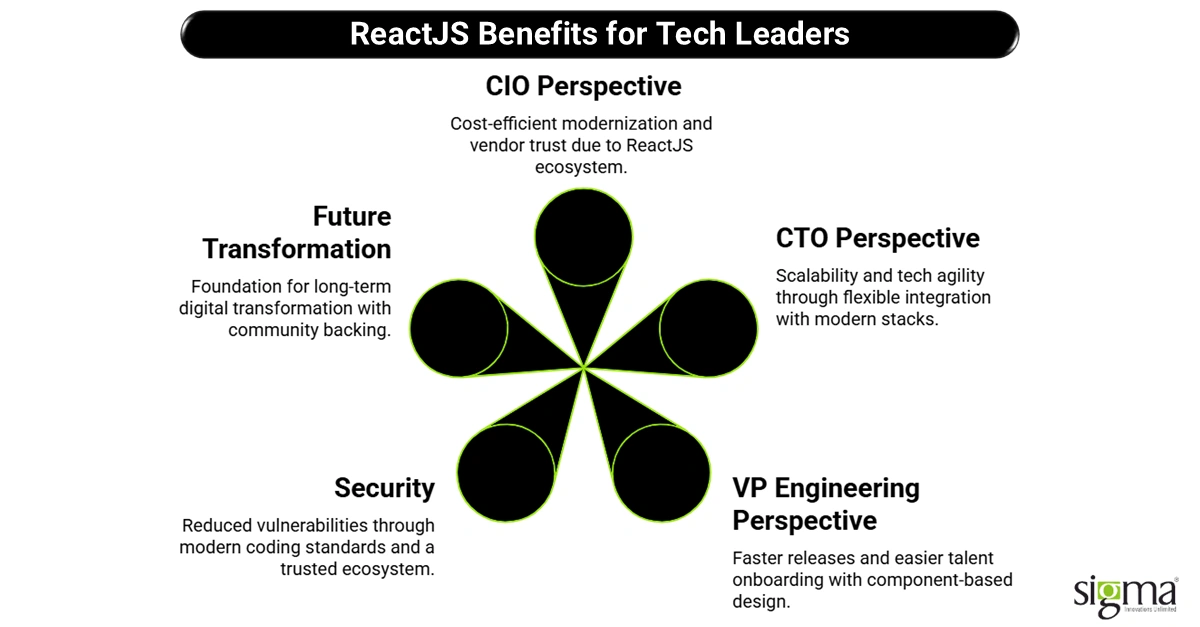How ReactJS Fixes Frontend Performance Bottlenecks
Key Takeaways:
- Stop Leaks Before They Sink You – Inefficient frontends are like leaky pipes; ReactJS patches the gaps and keeps your digital engine running smoothly.
- Shift From Horsepower to Jet Engines – ReactJS upgrades your frontend from sluggish to supersonic, cutting load times and scaling without the drag.
- Future-Proof Like a Solid Foundation – With ReactJS + Sigma, you’re not just building walls—you’re laying the concrete for digital growth that lasts.
Picture this: your enterprise web app loads with a half-second lag. Will a half-second lag impact your enterprise’s bottom line? In fact, studies show that just a 1-second delay in page load can slash conversions by about 7%. For high-traffic or high-value B2B experiences, that’s not just annoying—it’s expensive. Every extra second of latency risks lost leads, frustrated decision-makers, and even subtle brand damage.
Performance isn’t just a technical checkbox anymore—it’s a strategic issue. For CIOs, CTOs, and VPs of Engineering managing tight budgets, complex codebases, and growing feature demands, a slow frontend is both a financial drag and a barrier to digital leadership. Legacy code, bloated JavaScript, and inefficient rendering pipelines can stall agility and trust with your most important users.
Here’s the good news: ReactJS, a leading JavaScript frontend framework, has evolved into the go-to solution for enterprise-grade modernization. With its ReactJS performance optimization, ReactJS scalability, and smart rendering approach, ReactJS delivers the responsiveness your business needs—and your users expect.
In this article, you’ll see how turning to ReactJS development services offers a powerful, cost-effective way to fix performance bottlenecks—without uprooting your entire stack.
Why Inefficient Frontends Hurt Business
When it comes to enterprise applications, a clunky or inefficient frontend isn’t just a UX issue—it’s a business problem with ripple effects across revenue, costs, and competitiveness.

- Revenue Impact: Think about eCommerce checkout flows or Fintech onboarding journeys. If pages lag or buttons respond slowly, users bail. Research shows that nearly 70% of shoppers abandon carts—and slow performance is one of the biggest culprits. Reduced engagement translates to fewer conversions, shorter session times, and ultimately, weaker customer retention.
- Operational Costs: Maintaining a legacy frontend is like patching up an old car. It gets more expensive the longer you keep it running. IT teams spend extra time and money firefighting performance issues, applying quick fixes, and running heavy infrastructure just to keep apps functional. These hidden costs eat into budgets that could otherwise drive innovation.
- Tech Debt & Talent Challenges: Old codebases also build up tech debt. They’re harder to scale, and onboarding new developers becomes painful. For modern engineering teams, outdated frontends mean productivity drags and frustration rises. It’s tough to attract top talent when your stack feels like it’s stuck in the past.
Read the blog to learn more about mitigating technical debt with the best technology services.
- Competitive Pressure: Meanwhile, digitally agile competitors are shipping faster, optimizing continuously, and winning users with smooth, modern experiences. Falling behind here isn’t just about tech—it’s about market share and brand relevance.
How Decision-Makers Experience This
- CIOs feel the pain through higher costs and heightened security risks in outdated frameworks.
- CTOs struggle with tech stack agility—unable to pivot quickly or integrate new tools.
- VPs of Engineering face daily headaches in team productivity, juggling bug fixes over building new features.
In short, inefficient frontends hit enterprises where it hurts most: the bottom line, agility, and reputation. That’s why forward-looking leaders are rethinking frontend strategy—and increasingly, turning to modern frameworks like ReactJS to future-proof their digital experiences.
Common Frontend Performance Bottlenecks in Modern Applications
If you’ve ever felt like your frontend is slowing the entire business down, you’re not alone. Many enterprises—even those investing heavily in digital—run into the same recurring performance bottlenecks. These aren’t just minor glitches; they directly impact scalability, user experience, and long-term costs.
Here are the most common culprits:

- Slow Rendering and Re-rendering: Every time a page element updates, sluggish rendering drags the entire app down. Users feel this as stuttering scrolls, delayed clicks, or spinning loaders. Over time, these micro-delays add up to major user frustration.
- Inefficient State Management: As applications grow in complexity, managing component states becomes tricky. Without efficient systems, data updates ripple across the app unnecessarily, making everything feel slower and harder to maintain.
- Bloated Bundles and Unoptimized Code: Think of bloated bundles like a backpack overloaded with things you don’t need. Large JavaScript files and unoptimized assets force browsers to work harder, leading to longer load times—especially painful on mobile or global deployments.
- Third-Party Integrations Dragging Performance: Payment gateways, analytics, and chat widgets often run outside your direct control. Poorly optimized integrations can become performance roadblocks, slowing down even the best-built frontend solutions.
- Legacy Architecture with Patchwork Fixes: Many enterprises keep layering “quick fixes” on top of legacy systems. This patchwork creates fragile architectures that buckle under scale, making modernization more difficult down the road.
- Security Vulnerabilities in Outdated Frameworks: Older frontend frameworks not only struggle with speed but also create security blind spots. With cyber threats on the rise, this is a risk CIOs can’t afford to ignore.
For decision-makers, these bottlenecks show up in different ways: slower release cycles, higher maintenance costs, and teams spending more time fixing issues than building value. The result? A frontend that feels more like a liability than a growth driver.
This is exactly why many enterprises are embracing modern JavaScript frontend frameworks like ReactJS. With its ReactJS ecosystem, proven track record in ReactJS performance optimization, and support for scalable frontend architecture with ReactJS, it helps businesses break free from these bottlenecks and focus on delivering seamless digital experiences.
Also Read: Breaking Down Front End Engineering and Development for Agile Tech Projects
Why ReactJS is the Answer to Enterprise Performance Challenges
When enterprises decide it’s time to modernize, the question isn’t if they need a stronger frontend—it’s which framework will get them there. For many, the answer is ReactJS. Here’s why it continues to dominate as the go-to choice for enterprise-level frontend solutions:
- Virtual DOM Advantage – Faster Rendering: Traditional rendering can feel like repainting an entire house when you just need to touch up one wall. ReactJS fixes that with its Virtual DOM, updating only what’s necessary. The result? Faster rendering and smoother user experiences, even in complex apps.
- Component-Based Architecture – Reusable, Scalable, Future-Proof: ReactJS applications are built like Lego sets: small, reusable blocks (components) that snap together. This makes apps easier to scale, maintain, and evolve—perfect for enterprises juggling multiple teams and product lines.
- Rich Ecosystem – Integrations, Libraries, Community Support: The ReactJS ecosystem is vast. Whether you need analytics, state management, or third-party integrations, chances are there’s already a proven solution. Plus, a thriving global community ensures continuous updates, security patches, and best practices for ReactJS performance optimization.
- SEO & Mobile-First Readiness: For industries like eCommerce and Fintech, visibility and accessibility are non-negotiable. ReactJS supports server-side rendering and mobile-first designs, making it easier to build apps that rank well and perform flawlessly across devices.
- Performance Optimization Tools: Features like memoization, lazy loading, and React Suspense allow teams to fine-tune performance. These tools make optimizing web apps with ReactJS a more precise, controlled process, ensuring enterprise apps stay fast at scale.
Why Enterprises Choose ReactJS Over Angular/Vue

Angular and Vue are strong frameworks, but when it comes to ReactJS scalability and enterprise adoption, ReactJS consistently leads. Its balance of flexibility, performance, and ecosystem maturity makes it the safest bet for large-scale applications that need to evolve quickly.
For CIOs, CTOs, and VPs of Engineering, ReactJS isn’t just another framework—it’s a strategic asset. It helps reduce tech debt, accelerates feature delivery, and ensures digital experiences keep up with user expectations. In short, ReactJS isn’t just keeping pace with the enterprise—it’s setting the standard.
Strategic Value for Tech Leaders: Modernization, Scale, and Security
For enterprise tech leaders, frontend modernization isn’t about chasing the latest trend—it’s about driving measurable business value while balancing cost, agility, and security. ReactJS development services bring that balance to the table, making it easier for leaders to align technology with long-term strategy.

CIO POV → Cost-Efficient Modernization + Vendor Trust
CIOs care about value: getting the most out of budgets while keeping risk under control. With ReactJS, modernization becomes cost-effective. Instead of a full rip-and-replace, enterprises can incrementally rebuild parts of their applications, reducing upfront investment. Plus, ReactJS’s global adoption and strong ReactJS ecosystem mean there’s a reliable vendor network to trust.
CTO POV → Scalability + Tech Agility
For CTOs, the name of the game is agility. ReactJS supports scalable frontend architecture with ReactJS, letting teams expand features without heavy rework. Its flexibility makes integrating with modern stacks—cloud-native, API-first, or microfrontend architecture with ReactJS—far easier. The payoff? Faster pivots, quicker integrations, and technology that doesn’t hold back innovation.
VP Engineering POV → Talent Onboarding + Faster Releases
Ask any VP of Engineering, and they’ll tell you: productivity and talent matter just as much as tech. With ReactJS’s component-based design and widely adopted practices, new developers ramp up quickly. Teams spend less time untangling legacy code and more time shipping features. That means faster release cycles and happier engineering teams.
Security-First Design
In industries like Fintech and eCommerce, security isn’t optional—it’s mission-critical. ReactJS helps reduce vulnerabilities by supporting modern coding standards, frequent updates, and a trusted ecosystem. Enterprises can address compliance requirements while still optimizing performance.
Future-Ready Digital Transformation
ReactJS isn’t just a patch for slow apps—it’s a foundation. With strong community backing, ongoing innovation, and proven enterprise adoption, it positions organizations for the long haul. For CIOs, CTOs, and VPs of Engineering, ReactJS represents not just a frontend choice, but a future-ready digital transformation strategy.
Also Read: Advancing Chatbot Capabilities with Full-Stack AI Development Services
Sigma Infosolutions’ ReactJS Development Services
At Sigma, we don’t believe in one-size-fits-all solutions. Our ReactJS development services are designed for enterprises that want more than just apps—they want secure, scalable, and high-performing digital platforms that actually move the needle on business outcomes.
Our Differentiators
- Enterprise-Grade ReactJS Development – We build applications that meet enterprise standards for performance, scalability, and compliance. Whether it’s high-traffic eCommerce portals or data-intensive Fintech platforms, our solutions are built to last.
- Custom Solutions Across Industries – From retail to SaaS to financial services, we understand the unique needs of each vertical. Our teams create tailored ReactJS solutions that align with your business goals—not cookie-cutter templates.
- Secure, Scalable, and Performance-First Builds – Every line of code we ship is guided by best practices for ReactJS performance optimization and industry-grade security standards. We help businesses avoid tech debt while preparing them for growth.
Engagement Models That Fit Your Needs
Every organization scales differently, which is why we offer flexible engagement options:
- Dedicated Teams – Your own team of ReactJS specialists working as an extension of your in-house staff.
- Project-Based Delivery – For initiatives with a clear scope and timeline.
- Staff Augmentation – Scale your engineering bandwidth instantly with top-tier ReactJS developers.
Integration Expertise
Modern enterprises rarely operate in silos. That’s why we ensure our ReactJS applications integrate seamlessly with your ecosystem—be it Salesforce, AWS Cloud, Adobe Commerce (Magento), Shopify, or custom APIs. Our integration-first mindset helps you achieve a connected, future-ready digital environment.
Why Settle for Patchwork Fixes?
Legacy workarounds and piecemeal upgrades only delay the inevitable. The smarter path is modernization—with a trusted partner who understands your business and your tech. As a ReactJS development company in the USA, Sigma combines technical expertise with deep industry knowledge to deliver enterprise-level frontend solutions that are future-proof.
Why settle for patchwork fixes when you can modernize with Sigma Infosolutions? Let’s build your next digital experience with ReactJS development services that keep you competitive, secure, and scalable!
The ROI of Choosing ReactJS with Sigma
When tech leaders weigh frontend modernization, the question always comes down to return on investment. With ReactJS development services from Sigma, the ROI speaks for itself:
- Reduced Total Cost of Ownership (TCO): By eliminating bloated legacy frontends and embracing efficient, reusable ReactJS components, enterprises spend less on maintenance and infrastructure. That’s budget freed up for true innovation instead of firefighting.
- Faster Time-to-Market: In industries like Fintech and eCommerce, speed is strategy. Our ReactJS solutions enable quicker rollouts, continuous iteration, and faster feature delivery. That means your business can seize opportunities before competitors do.
- Improved Customer Retention & Revenue Growth: Every millisecond saved boosts engagement. Optimized apps built with ReactJS reduce friction, improve user satisfaction, and increase loyalty—directly impacting revenue growth.
- Long-Term Scalability: Unlike patchwork fixes that crumble at scale, ReactJS supports growth without constant re-architecture. Sigma’s focus on scalable frontend architecture with ReactJS ensures your platforms evolve smoothly as your business grows.
The result? A modern frontend that doesn’t just solve today’s performance bottlenecks but sets your enterprise up for future success. With Sigma Infosolutions as your ReactJS development company in the USA, ROI isn’t just about cost savings—it’s about driving long-term business impact.
Final Thoughts
Inefficient frontends don’t just slow apps—they slow businesses. From lost revenue and higher maintenance costs to frustrated teams and missed market opportunities, the cost of sticking with outdated architectures adds up fast.
That’s why leading enterprises are turning to ReactJS. With its performance optimization, scalability, and future-ready architecture, ReactJS delivers the speed, flexibility, and resilience modern businesses demand.
At Sigma, we bring ReactJS to life for enterprises across eCommerce, Fintech, and SaaS. Our ReactJS development services are designed to cut tech debt, accelerate releases, and ensure every digital touchpoint works seamlessly at scale. Whether you need a new build, modernization, or integration with Salesforce, AWS, or Adobe Commerce, our expertise ensures you get enterprise-grade results without compromise.
Partner with Sigma Infosolutions to build enterprise-grade ReactJS applications that don’t just perform—they power your digital transformation.
Explore our ReactJS Development Services or Contact Us today to start your journey toward faster, smarter, and more scalable digital experiences!
